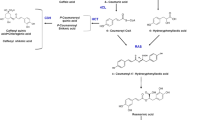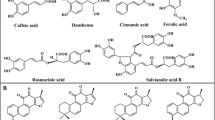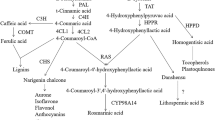Abstract
Salvia miltiorrhiza, a traditional Chinese medicinal herb, contains two groups of bioactive components: lipid-soluble tanshinones and water-soluble phenolic acids. Many researchers have recently focused on elicitation of secondary metabolites to improve their production. In this paper, folic acid was used as an elicitor to stimulate phenolics production in S. miltiorrhiza hairy root cultures. The results showed that folic acid use was effective for eliciting rosmarinic acid (RA), salvianolic acid B (SAB), caffeic acid (CA), and total phenolics from S. miltiorrhiza hairy roots and that 50 μM is the most effective folic acid concentration for elicitation. Roots treated with 50 μM folic acid showed 97.6, 76.7, and 47 % increases in RA, SAB, and CA contents, respectively, relative to the control. The expression of three key genes involved in SAB biosynthesis (i.e., PAL, TAT, and RAS) were upregulated by folic acid. In conclusion, we report for the first time that folic acid is an effective elicitor of phenolics production in S. miltiorrhiza hairy roots. Our results suggest that folic acid is a potential elicitor that may improve phenolic acid production in medicinal plants.









Similar content being viewed by others
Abbreviations
- RA:
-
Rosmarinic acid
- CA:
-
Caffeic acid
- SAB:
-
Salvianolic acid B
- MeJA:
-
Methyl jasmonate
- YE:
-
Yeast extract
- ABA:
-
Abscisic acid
- PAL:
-
Phenylalanine ammonia lyase
- RAS:
-
Rosmarinic acid synthase-like
- TAT:
-
Tyrosine aminotransferase
References
Ames TD, Rodionov DA, Weinberg Z, Breaker RR (2010) A eubacterial riboswitch class that senses the coenzyme tetrahydrofolate. Chem Biol 17:681–685
Blancquaert D, Storozhenko S, Loizeau K, De Steur H, De Brouwer V, Viaene J, Ravanel S, Rébeillé F, Lambert W, Van Der Straeten D (2010) Folates and folic acid: from fundamental research toward sustainable health. Crit Rev Plant Sci 29:14–35
Burguieres E, McCue P, Kwon YI, Shetty K (2007) Effect of vitamin C and folic acid on seed vigour response and phenolic-linked antioxidant activity. Bioresour Technol 98:1393–1404
Chen H, Chena F, Chiu FC, Lo CM (2001) The effect of yeast elicitor on the growth and secondary metabolism of hairy root cultures of Salvia miltiorrhiza. Enzyme Microb Technol 28:100–105
Cheng QQ, He YF, Li G, Liu YJ, Gao W, Huang LQ (2013) Effects of combined elicitors on tanshinone metabolic profiling and SmCPS expression in Salvia miltiorrhiza hairy root cultures. Molecules 18:7473–7485
Choi SW, Friso S (2005) Interactions between folate and aging for carcinogenesis. Clin Chem Lab Med 43:1151–1157
Cook RJ (2001) Disruption of histidine catabolism in NEUT2 mice. Arch Biochem Biophys 392:226–232
Dong J, Wan G, Liang Z (2010) Accumulation of salicylic acid-induced phenolic compounds and raised activities of secondary metabolic and antioxidative enzymes in Salvia miltiorrhiza cell culture. J Biotechnol 148:99–104
Du SR, Xiang TH, Song YL, Huang LX, Sun Y, Han YX (2015) Transgenic hairy roots of Tetrastigma hemsleyanum: induction, propagation, genetic characteristics and medicinal components. Plant Cell Tissue Organ Cult 122:373–382
Ferrer JL, Austin M, Stewart C Jr, Noel J (2008) Structure and function of enzymes involved in the biosynthesis of phenylpropanoids. Plant Physiol Biochem 46:356–370
Gao YS, Alvarez C, Nelson DS, Sztul E (1998) Molecular cloning, characterization, and dynamics of rat formiminotransferase cyclodeaminase, a Golgi-associated 58-kDa protein. J Biol Chem 273:33825–33834
Ge X, Wu J (2005) Tanshinone production and isoprenoid pathways in Salvia miltiorrhiza hairy roots induced by Ag+ and yeast elicitor. Plant Sci 168:487–491
Guillon S, Trémouillaux-Guiller J, Pati PK, Rideau M, Gantet P (2006) Hairy root research: recent scenario and exciting prospects. Curr Opin Plant Biol 9:341–346
Hao GP, Ji HW, Li YL, Shi RJ, Wang JM, Feng L, Huang LQ (2012) Exogenous ABA and polyamines enhanced salvianolic acids contents in hairy root cultures of Salvia miltiorrhiza Bge. f.alba. Plant Omics 5:446–452
Hirai MY, Klein M, Fujikawa Y, Yano M, Goodenowe DB, Yamazaki Y, Kanaya S, Nakamura Y, Kitayama M, Suzuki H, Sakurai N, Shibata D, Tokuhisa J, Reichelt M, Gershenzon J, Papenbrock J, Saito K (2005) Elucidation of gene-to-gene and metabolite-to-gene networks in Arabidopsis by integration of metabolomics and transcriptomics. J Biol Chem 280:25590–25595
Kai G, Xu H, Zhou C, Liao P, Xiao J, Luo X, You L, Zhang L (2011) Metabolic engineering tanshinone biosynthetic pathway in Salvia miltiorrhiza hairy root cultures. Metab Eng 13:319–327
Li YG, Song L, Liu M, Hu ZB, Wang ZT (2009) Advancement in analysis of Salviae miltiorrhizae Radix et Rhizoma (Danshen). J Chromatogr A 1216:1941–1953
Liao P, Zhou W, Zhang L, Wang J, Yan XM, Zhang Y, Zhang R, Li L, Zhou GY, Kai GY (2009) Molecular cloning, characterization and expression analysis of a new gene encoding 3-hydroxy-3-methylglutaryl coenzyme A reductase from Salvia miltiorrhiza. Acta Physiol Plant 31:565–572
Liu AH, Li L, Xu M, Lin YH, Guo HZ, Guo DA (2006) Simultaneous quantification of six major phenolic acids in the roots of Salvia miltiorrhiza and four related traditional Chinese medicinal preparations by HPLC-DAD method. J Pharm Biomed Anal 41:48–56
Malhotra K, Kim S-T, Sancar A (1994) Characterization of a medium wavelength type DNA photolyase: purification and properties of photolyase from Bacillus firmus. Biochemistry 33:8712–8718
Ming QL, Su CY, Zheng CJ, Jia M, Zhang QY, Zhang H, Rahman K, Han T, Qin LP (2013) Elicitors from the endophytic fungus Trichoderma atroviride promote Salvia miltiorrhiza hairy root growth and tanshinone biosynthesis. J Exp Bot 64:5687–5694
Mizukami H, Tabira Y, Ellis BE (1993) Methyl jasmonate-induced rosmarinic acid biosynthesis in Lithospermum erythrorhizon cell suspension cultures. Plant Cell Rep 12:706–709
Mohr PG, Cahill DM (2007) Suppression by ABA of salicylic acid and lignin accumulation and the expression of multiple genes, in Arabidopsis infected with Pseudomonas syringae pv. tomato. Funct Integr Genomics 7:181–191
Ogata A, Tsuruga A, Matsuno M, Mizukami H (2004) Elicitor-induced rosmarinic acid biosynthesis in Lithospermum erythrorhizon cell suspension cultures: activities of rosmarinic acid synthase and the final two cytochrome P450-catalyzed hydroxylations. Plant Biotechnol 21:393–396
Park EJ, Zhao YZ, Kim YC, Sohn D (2009) Preventive effects of a purified extract isolated from Salvia miltiorrhiza enriched with tanshinone I, tanshinone IIA and cryptotanshinone on hepatocyte injury in vitro and in vivo. Food Chem Toxicol Int J Publ Br Ind Biol Res Assoc 47:2742–2748
Petersen M, Häusler E, Karwatzki B, Meinhard J (1993) Proposed biosynthetic pathway for rosmarinic acid in cell cultures of Coleus blumei Benth. Planta 189:10–14
Petersen M, Abdullah Y, Benner J, Eberle D, Gehlen K, Hücherig S, Janiak V, Kim KH, Sander M, Weitzel C, Wolters S (2009) Evolution of rosmarinic acid biosynthesis. Phytochemistry 70:1663–1679
Rader JI, Schneeman BO (2006) Prevalence of neural tube defects, folate status, and folate fortification of enriched cereal-grain products in the United States. Pediatrics 117:1394–1399
Shi M, Kwok KW, Wu JY (2007) Enhancement of tanshinone production in Salvia miltiorrhiza Bunge (red or Chinese sage) hairy-root culture by hyperosmotic stress and yeast elicitor. Biotechnol Appl Biochem 46:191–196
Song J (2010) Function analysis of the genes involved in rosmarinic acid biosynthesis pathway in Salvia miltiorrhiza Bunge. Unpublished PhD thesis, Shaanxi Normal University, Xian, China
Song J, Wang ZZ (2011) RNAi-mediated suppression of the phenylalanine ammonia-lyase gene in Salvia miltiorrhiza causes abnormal phenotypes and a reduction in rosmarinic acid biosynthesis. J Plant Res 124:183–192
Storozhenko S, Navarrete O, Ravanel S, De Brouwer V, Chaerle P, Zhang GF, Bastien O, Lambert W, Rebeille F, Van Der Straeten D (2007) Cytosolic hydroxymethyldihydropterin pyrophosphokinase/dihydropteroate synthase from Arabidopsis thaliana—a specific role in early development and stress response. J Biol Chem 282:10749–10761
Vaccaro M, Malafronte N, Alfieri M, Tommasi ND, Leone A (2014) Enhanced biosynthesis of bioactive abietane diterpenes by overexpressing AtDXS or AtDXR genes in Salvia sclarea hairy roots. Plant Cell Tissue Organ Cult 119:65–77
Wang J, Xia Z, Tan R (2001) Elicitation on artemisinin biosynthesis in Artemisia annua hairy roots by the oligosaccharide extract from the endophytic Colletotrichum sp. B501. Acta Bot Sin 44:1233–1238
Wang X, Cui G, Huang L, Qiu D (2007a) Effects of methyl jasmonat on accumulation and release of tanshinones in suspension cultures of Salvia miltiorrhiza hairy root. China J Chin Mater Med 32:300–302
Wang X, Morris-Natschke SL, Lee KH (2007b) New developments in the chemistry and biology of the bioactive constituents of Tanshen. Med Res Rev 27:133–148
Wang ZJ, Cui LJ, Chen C, Liu XJ, Yan YP, Wang ZZ (2012) Downregulation of cinnamoyl CoA reductase affects lignin and phenolic acids biosynthesis in Salvia miltiorrhiza Bunge. Plant Mol Biol Rep 30:1229–1236
Webb ME, Smith AG (2009) Chlorophyll and folate: intimate link revealed by drug treatment. New Phytol 182:3–5
Wu JY, Shi M (2008) Ultrahigh diterpenoid tanshinone production through repeated osmotic stress and elicitor stimulation in fed-batch culture of Salvia miltiorrhiza hairy roots. Appl Microbiol Biotechnol 78:441–448
Wu YP, Zhao XM, Pan SD, Guo DA, Wei R, Han JJ, Kainoh M, Xia ZL, de Groot PG, Lisman T (2008) Salvianolic acid B inhibits platelet adhesion under conditions of flow by a mechanism involving the collagen receptor α2β1. Thromb Res 123:298–305
Xiao Y, Gao SH, Di P, Chen JF, Chen WS, Zhang L (2009) Methyl jasmonate dramatically enhances the accumulation of phenolic acids in Salvia miltiorrhiza hairy root cultures. Physiol Plant 137:1–9
Xiao Y, Gao SH, Di P, Chen JF, Chen WS, Zhang L (2010) Lithospermic acid B is more responsive to silver ions (Ag+) than rosmarinic acid in Salvia miltiorrhiza hairy root cultures. Biosci Rep 30:33–40
Xing BC, Yang DF, Guo WL, Liang ZS, Yan XJ, Zhu YH, Liu Y (2014) Ag+ as a more effective elicitor for production of tanshinones than phenolic acids in Salvia miltiorrhiza hairy roots. Molecules 20:309–324
Xu H, Zhang L, Zhou C, Xiao J, Liao P, Kai G (2010) Metabolic regulation and genetic engineering of pharmaceutical component tanshinone biosynthesis in Salvia miltiorrhiza. J Med Plants Res 4:2591–2597
Yan Y, Zhang S, Zhang J, Ma P, Duan J, Liang Z (2014) Effect and mechanism of endophytic bacteria on growth and secondary metabolite synthesis in Salvia miltiorrhiza hairy roots. Acta Physiol Plant 36:1095–1105
Yang DF, Ma PD, Liang X, Wei Z, Liang ZS, Liu Y, Liu FH (2012a) PEG and ABA trigger methyl jasmonate accumulation to induce the MEP pathway and increase tanshinone production in Salvia miltiorrhiza hairy roots. Physiol Plant 146:173–183
Yang DF, Sheng DF, Duan QM, Liang X, Liang ZS, Liu Y (2012b) PEG and ABA trigger the burst of reactive oxygen species to increase tanshinone production in Salvia miltiorrhiza hairy roots. J Plant Growth Regul 31:579–587
Zhang S, Yan Y, Wang B, Liang Z, Liu Y, Liu F, Qi Z (2014a) Selective responses of enzymes in the two parallel pathways of rosmarinic acid biosynthetic pathway to elicitors in Salvia miltiorrhiza hairy root cultures. J Biosci Bioeng 117:645–651
Zhang Y, Yan Y-P, Wu Y-C, Hua W-P, Chen C, Ge Q, Wang Z-Z (2014b) Pathway engineering for phenolic acid accumulations in Salvia miltiorrhiza by combinational genetic manipulation. Metab Eng 21:71–80
Zhao JL, Zhou LG, Wu JY (2010) Effects of biotic and abiotic elicitors on cell growth and tanshinone accumulation in Salvia miltiorrhiza cell cultures. Appl Microbiol Biotechnol 87:137–144
Zhou L, Zuo Z, Chow MSS (2005) Danshen: an overview of its chemistry, pharmacology, pharmacokinetics, and clinical use. J Clin Pharm 45:1345–1359
Acknowledgments
This material is based upon work funded by Zhejiang Provincial Natural Science Foundation of China (No. LZ16H280001), National Natural Science Foundation of China (Nos. 81373908 and 81403033), 521 Talent Program of Zhejiang Sci-tech University and China Postdoctoral Science Foundation Funded Project (Nos. 2014M551771 and 2015T80223). The funders have no role in study design, data collection and analysis, decision to publish, or preparation of the manuscript.
Author information
Authors and Affiliations
Corresponding author
Ethics declarations
Conflict of interest
The authors declare that they have no conflict of interest.
Rights and permissions
About this article
Cite this article
Yang, D., Huang, Z., Xing, B. et al. Regulation of folic acid on phenolic acids production in Salvia miltiorrhiza hairy roots. Plant Cell Tiss Organ Cult 127, 175–185 (2016). https://doi.org/10.1007/s11240-016-1040-3
Received:
Accepted:
Published:
Issue Date:
DOI: https://doi.org/10.1007/s11240-016-1040-3




